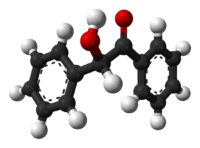- Benzoin
-
Benzoin 
 2-hydroxy-1,2-di(phenyl)ethanoneOther names2-hydroxy-2-phenylacetophenone, 2-hydroxy-1,2-diphenylethanone, desyl alcohol, bitter almond oil camphor
2-hydroxy-1,2-di(phenyl)ethanoneOther names2-hydroxy-2-phenylacetophenone, 2-hydroxy-1,2-diphenylethanone, desyl alcohol, bitter almond oil camphorIdentifiers CAS number 119-53-9 
PubChem 8400 ChemSpider 8093 
UNII L7J6A1NE81 
KEGG C01408 
ChEBI CHEBI:17682 
ChEMBL CHEMBL190677 
Jmol-3D images Image 1
Image 2- O=C(c1ccccc1)C(O)c2ccccc2
c1ccc(cc1)C(C(=O)c2ccccc2)O
Properties Molecular formula C14H12O2 Molar mass 212.24 g mol−1 Appearance off-white crystals Density 1.31 g/cm3 Melting point 132-137 °C
Boiling point 344 °C
Solubility in water Slightly Soluble Solubility in Chlorine Soluble Hazards NFPA 704  (verify) (what is:
(verify) (what is:  /
/ ?)
?)
Except where noted otherwise, data are given for materials in their standard state (at 25 °C, 100 kPa)Infobox references Benzoin (pronounced /ˈbɛnzoʊ.ɨn, -ɔɪn/) is an organic compound with the formula PhCH(OH)C(O)Ph. It is a hydroxy ketone attached to two phenyl groups. It appears as off-white crystals, with a light camphor-like odor. Benzoin is synthesized from benzaldehyde in the benzoin condensation. It is chiral and it exists as a pair of enantiomers: (R)-benzoin and (S)-benzoin.
Benzoin is not a constituent of benzoin resin obtained from the benzoin tree (Styrax) or tincture of benzoin. The main component in these natural products is benzoic acid.
Contents
History
Benzoin was first reported in 1832 by Justus von Liebig and Friedrich Woehler during their research on oil of bitter almond, which is benzaldehyde with traces of hydrocyanic acid.[1] The catalytic synthesis by the benzoin condensation was improved by Nikolay Zinin during his time with Liebig. [2][3]
Uses
The main uses of benzoin are as a precursor to benzil, which is a photoinitiator.[4] The conversion proceeds by organic oxidation with, copper(II), nitric acid, or oxone.[5] In one study, this reaction is carried out with atmospheric oxygen and basic alumina in dichloromethane.[6]
References
- ^ Wöhler, Liebig; Liebig (1832). "Untersuchungen über das Radikal der Benzoesäure". Annalen der Pharmacie 3 (3): 249–282. doi:10.1002/jlac.18320030302.
- ^ N. Zinin (1839). "Beiträge zur Kenntniss einiger Verbindungen aus der Benzoylreihe". Annalen der Pharmacie 31 (3): 329–332. doi:10.1002/jlac.18390310312.
- ^ N. Zinin (1840). "Ueber einige Zersetzungsprodukte des Bittermandelöls". Annalen der Pharmacie 34 (2): 186–192. doi:10.1002/jlac.18400340205.
- ^ Hardo Siegel, Manfred Eggersdorfer "Ketones" in Ullmann's Encyclopedia of Industrial Chemistry Wiley-VCH, 2002 by Wiley-VCH, Wienheim. doi:10.1002/14356007.a15_077
- ^ Clarke, H. T.; Dreger.E. E. (1941), "Benzil", Org. Synth., http://www.orgsyn.org/orgsyn/orgsyn/prepContent.asp?prep=cv1p0087; Coll. Vol. 1: 87
- ^ Konstantinos Skobridis, Vassiliki Theodorou, Edwin Weber (2006). "A very simple and chemoselective air oxidation of benzoins to benzils using alumina". Arkivoc 06-1798JP: 102–106. http://www.arkat-usa.org/ark/journal/2006/I10_General/1798/06-1798JP%20as%20published%20mainmanuscript.asp.
External links
- Benzoin synthesis, Organic Syntheses, Coll. Vol. 1, p.94 (1941); Vol. 1, p.33 (1921)
Categories:- Alcohols
- Arabic words and phrases
- Aromatic ketones
- O=C(c1ccccc1)C(O)c2ccccc2
Wikimedia Foundation. 2010.

